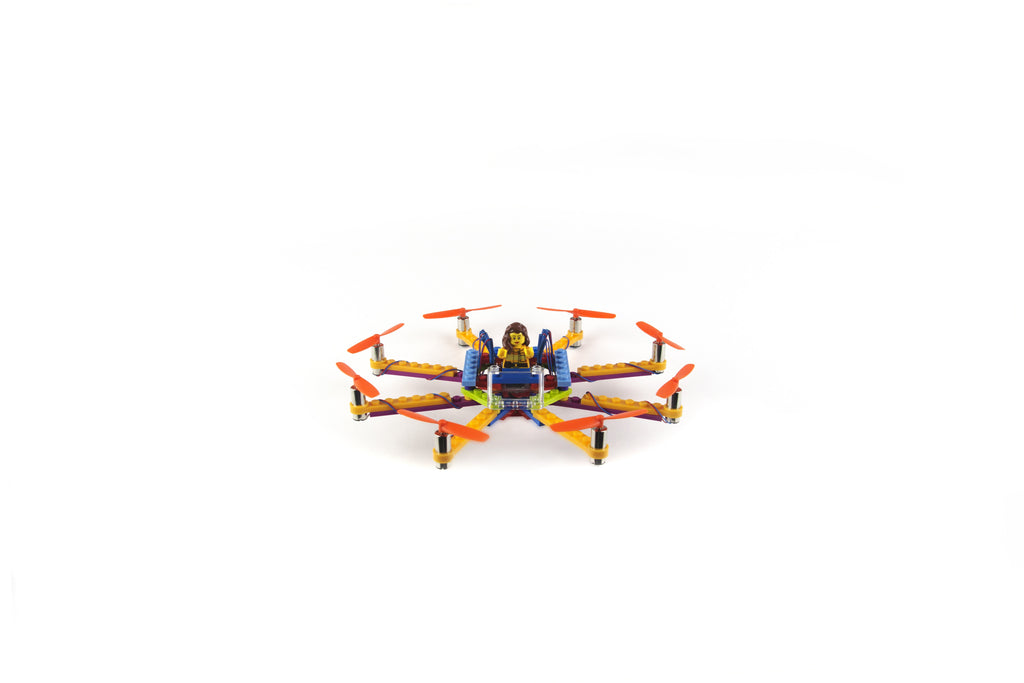Introducing the Flybrix Learn More About series. In each blog we’ll explore another aspect of flight, science, or technology -- and learn more about it. This week, we’re learning more about propellers.
Propellers play a crucial role in making all types of things go: from planes to boats to, of course, Flybrix drone kits. But how do propellers work? Let’s learn more about them!

What Is a Propeller?
A propeller is a piece of machinery that allows an object to move through a fluid, like water or air, by using rotation to produce a force called thrust. This thrust is a result of the air pressure being different on either side of the propeller’s blades. For example, when a plane propeller spins, air is pushed from the front of the blades to the back of the blades, causing the plane to move forward. You can observe a similar effect the next time you go swimming. When you move your arms through the water, they’re acting like propellers – moving you forward by pushing the water backward. Sure, that’s well and good for a person, but how do propellers move heavy things like aircraft, and across the sky no less? We’ll need to go back in time to get the whole picture.
History of the Propeller
One of the earliest forms of a propeller was developed by the Greek scientist Archimedes during the third century BC. “Archimedes’ screw,” as his invention came to be called, was used to raise water from a lower level to a higher one for the purposes of irrigation. Fast forward about two millennia to the 1800s, and screw propellers were being used to move large steamships. The use of propellers in aircraft, however, had been theorized long before that. Leonardo da Vinci’s famous fifteenth-century sketch of a flying machine, dubbed an aerial screw, included a spiral apparatus on top, making it look a lot like a modern-day helicopter. In the centuries that followed, propellers were implemented in a number of proposed aircraft -- most successfully Jules Henri Giffard’s steam-powered dirigible, which Giffard successfully piloted over France during a controlled flight in 1852. Fifty-one years later, in 1903, brothers Orville and Wilbur Wright achieved the first powered, controlled flight of an airplane -- and it was largely made possible by their innovative aeronautic propeller design.
How an Aeronautic Propeller Works
The Wright brothers had the ingenious idea of considering the blades of a propeller to be a collection of wings, which are flat on the bottom and curved on top. An airplane’s curved wings push wind toward the ground, thus creating lift, which is the force that allows planes to achieve flight. If you’ve ever stuck your hand out the window of a moving car, you’ve experienced lift, well, first hand! You’ve likely noticed that when you curve your hand upward, your arm wants to rise. And when you curve your hand downward, it wants to fall. This is exactly how curved wings help lift a plane into the air. Now, when these curved wings -- also called airfoils -- are twisted around a hub to form the blades of a rotating propeller, lift becomes thrust, which, as mentioned earlier, moves the plane forward through the air. The twisting of the blades is important, as it enables the propeller to hit the approaching wind at an optimal “angle of attack.” The Wright brothers’ incorporated two of these types of propellers in their Wright Flyer, which, amazingly, operated at nearly the same efficiency as today’s most advanced propellers.
How Propellers Help Drones Fly
Drones operate a lot like another type of aircraft: a helicopter. In order to fly, drones utilize vertically-mounted propellers – called rotors -- that provide both lift and thrust. Some of the most common types of drones, like the ones you can build with a Flybrix kit, are known as quadcopters because they use four rotors. Two rotors spin clockwise, while the other two spin counterclockwise, like this:
Drones are able to move forward, backward, and side-to-side by varying the speed of the clockwise-spinning rotors independently of the counterclockwise-spinning rotors. In order to ascend or descend, all four rotors either speed up or slow down.
Flybrix kits are a great way to check out this concept in action. As an experiment, see what happens when you build a drone with rotors all spinning in the same direction. Chances are you’ll have about as much luck getting it to fly as our old friends The Wrong Brothers. But build a drone with two sets or propellers spinning in opposite directions, and voila! You’ll be soaring to new heights.
Is there something you’d like to Learn More About? Contact us on Facebook and let us know! And be sure to experience some propeller magic for yourself with Flybrix kits.

